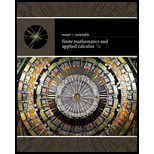
(a)
To calculate: The vertical position of a worn shock absorber on a car undergoes simple harmonic motion at
(b)
To calculate: The speed of changing the height of the car and the direction at times
(c)
To calculate: The frequency of oscillation of the car frame if a worn shock absorber on a car undergoes simple harmonic motion so that the height of the car frame after t seconds is given by
Want to see the full answer?
Check out a sample textbook solution
Chapter 16 Solutions
Finite Mathematics and Applied Calculus (MindTap Course List)
- CONCEPTS For an object in simple harmonic motion with amplitude a and period 2/, find an equation that models the displacement y at any time t if a y=0 at time t=0: y= ____________. b y=a at time t=0: y= ____________.arrow_forwardSimple Harmonic Motion In Exercises 45-48, find a model for simple harmonic motion satisfying the specified conditions. Displacementt=0AmplitudePeriod 03meters6secondsarrow_forwardAPPLICATIONS Shock Absorber When a car hits a certain bump on the road, a shock absorber on the car is compressed a distance of 6 in., then released see figure. The shock absorber vibrates in damped harmonic motion with frequency of 2 cycles per second. The damping constant for this particular shock absorber is 2.8. a Find an equation that describes the displacement of the shock absorber from its rest position as a function of time. Take t=0 to be the instant that the shock absorber is released. b How long does it take for the amplitude of the vibration to decrease to 0.5 in.?arrow_forward
- Oscillating Spring A mass attached to a spring oscillates upward and downward. The displacement of the mass from its equilibrium position after t seconds is given by the function d(t)=3.5cos(2t), where d is measured in centimeters (Figure 12). Find all times at which the displacement is zero.arrow_forwardSimple Harmonic Motion In Exercises 45-48, find a model for simple harmonic motion satisfying the specified conditions. Displacementt=0AmplitudePeriod 04centimeters2secondsarrow_forwardGear Trains Figure 8 shows a single-stage gear train. Gear trains are used in many products, such as clocks and automotive transmissions, to reduce or increase the angular velocity of a component. The size of each gear is measured by the number of teeth rather than the radius. Suppose the first gear has n1 and the second gear has n2 teeth. Because the spacing of the teeth is the same for both gears, the ratio of their radii will be equivalent to the corresponding ratio of the number of teeth. When two gears are meshed together, they share the same linear velocity. If 1 and 2 are the angular velocities of the first and second gears, respectively, then v2=v1r22=r112=r1r212=n1n21 The first gear in a single-stage gear train has 42 teeth and an angular velocity of 2 revolutions per second. The second gear has 7 teeth. Find the angular velocity of the second gear.arrow_forward
 Trigonometry (MindTap Course List)TrigonometryISBN:9781305652224Author:Charles P. McKeague, Mark D. TurnerPublisher:Cengage Learning
Trigonometry (MindTap Course List)TrigonometryISBN:9781305652224Author:Charles P. McKeague, Mark D. TurnerPublisher:Cengage Learning Algebra and Trigonometry (MindTap Course List)AlgebraISBN:9781305071742Author:James Stewart, Lothar Redlin, Saleem WatsonPublisher:Cengage LearningAlgebra & Trigonometry with Analytic GeometryAlgebraISBN:9781133382119Author:SwokowskiPublisher:Cengage
Algebra and Trigonometry (MindTap Course List)AlgebraISBN:9781305071742Author:James Stewart, Lothar Redlin, Saleem WatsonPublisher:Cengage LearningAlgebra & Trigonometry with Analytic GeometryAlgebraISBN:9781133382119Author:SwokowskiPublisher:Cengage Trigonometry (MindTap Course List)TrigonometryISBN:9781337278461Author:Ron LarsonPublisher:Cengage Learning
Trigonometry (MindTap Course List)TrigonometryISBN:9781337278461Author:Ron LarsonPublisher:Cengage Learning



